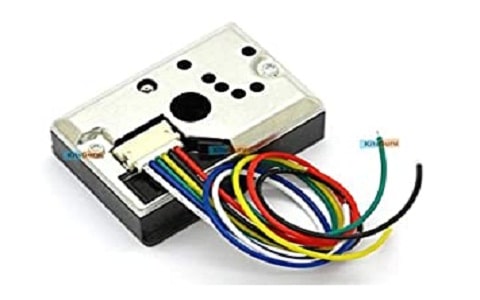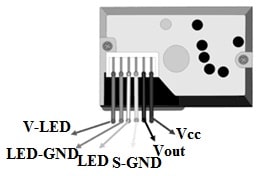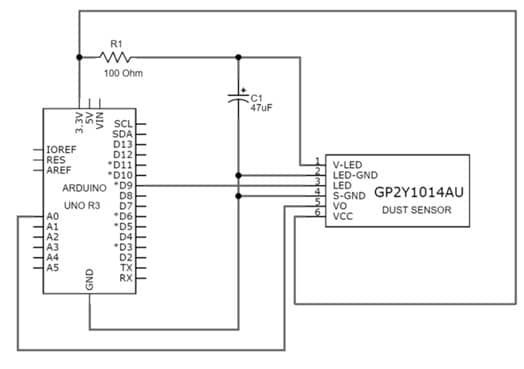Generally, air pollution can be caused by smoke, dust, wildfires, climate change, etc. At present, air pollution causes many health problems for human beings like different diseases Silicosis, Nausea, and Flu. So air quality measuring is very important and becoming more necessary in many cities. So GP2Y1010AU0F optical dust sensor is installed at various places like where high hygiene is required to detect the dust and air quality in the environment like hospitals, laboratories, restaurants, transportation, construction, etc. This article discusses an overview of a GP2Y1010AU0F Dust Sensor – pin configuration, working, and its applications.
What is GP2Y1010AU0F Dust Sensor?
GP2Y1010AU0F optical dust sensor is used to detect air quality and extremely fine dust particles with an optical sensing system like a light source within the air like smoke, cigarette, etc. This sensor is also called optical air quality sensor and it is normally utilized in air purifier systems. In this sensor, an IR light-emitting diode & a photodiode are arranged diagonally to detect the reflected light of dust within the air. This sensor has extremely low current consumption typically 11mA and 20mA max & it can be powered through up to 7VDC.

GP2Y1010AU0F Dust Sensor
Pin Configuration:
The pin configuration of a GP2Y1010AU0F dust sensor is shown below.

Pin Configuration
- Pin1 (V-LED): This is a VCC pin of LED. This pin is connected to 5V of Arduino with 150Ω Resistor
- Pin2 (LED-GND): This is a GND pin of LED. This pin is connected to the GND pin of the Arduino board.
- Pin3 (LED): This is used to Toggle LED ON or OFF. This pin is connected to Arduino’s digital pin.
- Pin4 (S-GND): This is the GND pin of the sensor & it must be connected to the GND pin of the Arduino board.
- Pin5 (Vout): This is the o/p pin of the sensor, so it can be connected to Arduino’s analog pin.
- Pin6 (VCC): This is the power pin of the sensor and it is connected to the 3.3V/5V pin of the Arduino.
Features & Specifications:
The features and specifications of the GP2Y1010AU0F dust sensor include the following.
- This sensor is compact.
- Lead-free & RoHS directive compliant.
- Operating voltage typically ranges from 4.5V – 5.5V.
- Less consumption of current – 20mA max.
- The size of detectable dust minimum is 0.5µm.
- Sensing range of dust density up to 580 µg/m3.
- Sensing time is < 1 Sec.
- The sensitivity is 0.5 V/(100 µg/m3).
- Operating temperature ranges from -10 C to +65 C.
- Its dimensions are 1.81 x 1.18 x 0.69.
GP2Y1010AU0F Dust Sensor Working
The dust sensor works on the principle of light scattering. This sensor uses an IR emitter LED as a transmitter and a Photodiode as a receiver. This dust sensor includes an airflow path, so both the IR LED & Photodiode are arranged near the Airflow path in the sensor.
The air enters the dust sensor using an air inlet valve where a light source illuminates the dust particles & the scattered light is changed into a signal through a photodiode. So these signals are simply amplified through the amplifier circuit after that it is processed to obtain the particle concentration. The scattered light intensity mainly depends on the particles of dust. When the dust particles are more within the air, then the light intensity will be higher. The o/p voltage at the sensor’s VOUT pin changes based on the scattered light intensity.
GP2Y1010AU0F Dust Sensor Interfacing with Arduino
The GP2Y1010AU0F dust sensor interfacing with Arduino Uno R3 is shown below.

GP2Y1010AU0F Dust Sensor Interfacing with Arduino
The required components for interfacing this mainly include Arduino UNO, Type A to B USB Cable, GP2Y1010AU0F dust sensor, 47uf capacitor, 100-ohm resistor, and jumper wires.
The connections of this interfacing follow as;
- The GND pin of the Arduino board is connected to S-GND and LED GND pins of the GP2Y1010AU0F dust sensor.
- The 3.3V of Arduino board is connected to VCC and V-LED pins of GP2Y1010AU0F through a 100-ohms resistor.
- The A0 pin of Arduino is connected to the VO pin of the GP2Y1010AU0F dust sensor.
- The D9 pin of the Arduino board is connected to the LED pin of GP2Y1010AU0F and it is declared as an o/p pin. The sensor’s Vo pin provides Analog o/p and then it is connected to the Analog i/p pin like ‘A0’ of Arduino.
Arduino Code
The Arduino code for interfacing the GP2Y1010AU0F dust sensor is shown below.
int sensePin = A0;
int ledPin = 9;
int Tsampling = 280;
int Tdelta = 40;
int Tsleep = 9680;
float outVo = 0;
float sigVolt = 0;
float dustLevel = 0;
void setup(){
Serial.begin(9600);
pinMode(ledPin,OUTPUT);
}
void loop(){
digitalWrite(ledPin,LOW);
delayMicroseconds(Tsampling);
outVo = analogRead(sensePin);
delayMicroseconds(Tdelta);
digitalWrite(ledPin,HIGH);
delayMicroseconds(Tsleep);
sigVolt = outVo * (3.3 / 1024);
dustLevel = 0.17 * sigVolt – 0.1;
Serial.print(“Measured Signal Value (0-1023): “);
Serial.print(outVo);
Serial.print(” Voltage: “);
Serial.print(sigVolt);
Serial.print(” Dust Density Level: “);
Serial.println(dustLevel);
delay(1000);
}
In the above code, first, you have to define the pins of the dust sensor that are connected through the
Arduino pins. In addition, define some other accessory elements.
In the void setup, the sensor pin mode needs to define as the output.
In a void loop, need to write the main program that has some formulas & the required output.
Applications
The uses of the GP2Y1010AU0F dust sensor include the following.
- This dust sensor is used to detect dust particles in the air.
- This sensor detects air quality.
- It is used in air monitors, air conditioners, and air purifiers.
- It is used in a filtering system.
- This sensor is installed in laboratories & hospitals.
- This sensor is used in the constriction field, professional cleaning sector, storage & transportation.
- It is used in the industrial sector, mainly in robotics & automation.
- It is used in the technology & energy sectors.
- It is used in the meteorology field.
- It is used in the agri-food sector.
Please refer to this link for GP2Y1010AU0F Dust Sensor Datasheet.
1. Does GP2Y1010AU0F dust sensor require / How to Calibrate GP2Y1010AU0F dust sensor ?
Yes, GP2Y1010AU0F dust sensor may require calibration to maintain its accuracy over time. Calibration involves adjusting the sensor’s output to match a known standard or reference value.
The calibration process for this sensor may involve using a reference instrument or a controlled environment with a known dust concentration to compare the sensor’s readings. The calibration frequency may depend on the specific application and environmental conditions.
2. What are the factors which affect the accuracy of the sensor ?
There are several factors which affect the accuracy of the sensor
- Environmental conditions.
- Dust particle Size and composition,
- Sensor orientation and placement.
- Caliberation.
- Electrical Noise.
3. Can GP2Y1010AU0F dust sensor detect other types of pollutants ?
It is primarily designed to detect the presence of airborne dust particles in the surrounding environment. However, it may also be sensitive to other types of airborne particulate matter, such as smoke, pollen , or other fine particles, depending on their size and composition.
While the sensor may be able to detect other types of pollutants, its important to note that it’s not specifically designed or calibrated for this purpose. The accuracy and sensitivity of the sensor may vary depending on the type and concentration of the pollutant in the air.
For monitoring other types of pollutants, such as gases or volatile organic compounds, other types of sensor , such as gas sensor or air quality monitors, may be more appropriate.
Thus, this is all about an overview of a GP2Y1010AU0F dust sensor – features, specifications, pin configuration, working, interfacing, and its applications. This is an optical detection system used in a steam cleaner, vacuum cleaner, or any other kind of cleaning device, or only fixed to a surface for detecting the finest dust particles. Alternative optical dust sensors are; DSM501A PM2.5 Dust Sensor & Nova PM Sensor SDS011.Here is a question for you, what is an air pollution sensor?